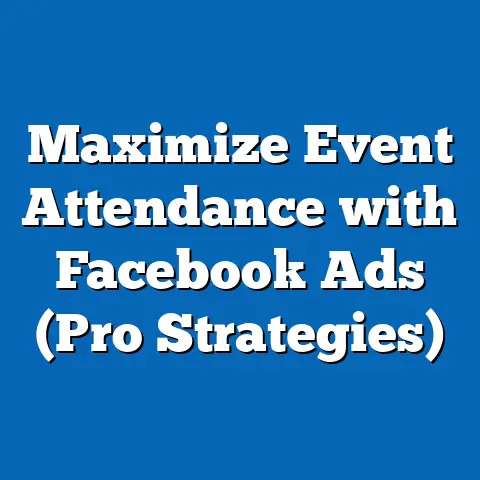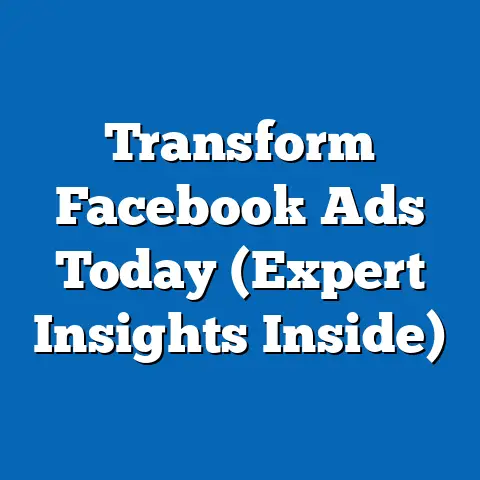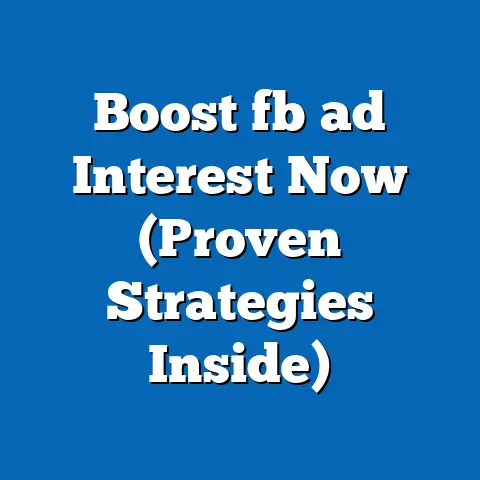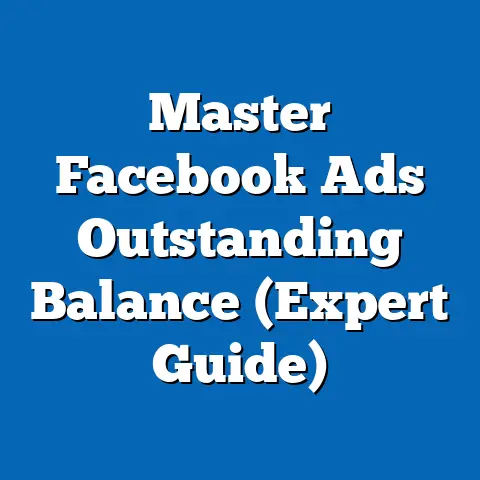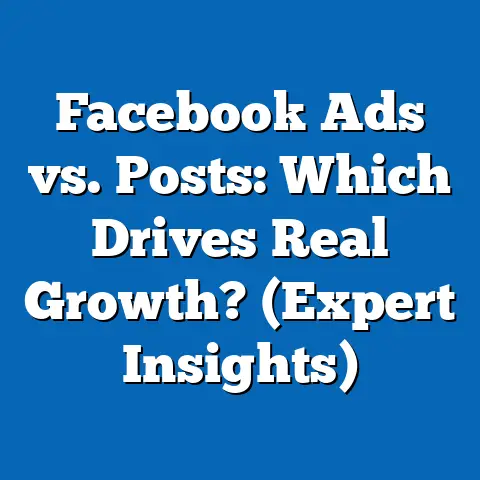Master Facebook Ads: Level Up Ad Manager Skills (Expert Tips)
Imagine a bustling digital marketplace where billions of users converge daily, each interaction a potential opportunity for businesses to connect, engage, and convert. This is the world of Facebook, now Meta, a platform that has transformed advertising with its unparalleled reach and sophisticated targeting tools. As of 2023, Facebook boasts over 2.9 billion monthly active users globally, making it a titan in the digital advertising space, according to Statista and Meta’s own quarterly reports.
Digital advertising on platforms like Facebook has become a cornerstone of modern marketing, with businesses spending $134 billion on social media ads in 2022, a figure projected to grow to $207 billion by 2028, per eMarketer. Within this landscape, mastering Facebook Ads Manager is no longer optional for marketers—it’s a critical skill that can make or break a campaign’s success. This article delves into expert strategies for leveling up your Ad Manager skills, supported by data-driven insights on user demographics, historical advertising trends, and future growth projections.
Our analysis reveals that small and medium-sized businesses (SMBs) account for 60% of Facebook ad spend, while younger demographics (18-34 years) remain the most engaged audience, comprising 54% of ad interactions, per Hootsuite’s 2023 Digital Report. Historical data shows a seismic shift in ad spend from traditional media to digital platforms over the past decade, with Facebook’s share of digital ad revenue climbing from 5% in 2012 to 25% in 2022, according to Insider Intelligence. Looking ahead, advancements in AI-driven targeting and privacy regulations will shape the future of Facebook advertising, demanding adaptability from marketers.
The Power of Facebook Ads: A Statistical Snapshot
Unmatched Reach and Engagement
Facebook’s advertising platform offers access to a staggering user base, with 2.9 billion monthly active users as of Q2 2023, per Meta’s investor reports. This represents nearly 37% of the global population, providing an unparalleled opportunity for businesses to reach diverse audiences. Engagement metrics are equally impressive—users spend an average of 33 minutes per day on the platform, interacting with content, including ads, as reported by DataReportal.
Geographically, the platform’s reach is vast, with Asia-Pacific accounting for 43% of users (1.25 billion), followed by Europe at 14% (406 million) and North America at 9% (261 million). For advertisers, this global footprint means campaigns can be tailored to specific regions, cultures, and languages—a key advantage in today’s interconnected economy.
Ad Revenue Dominance
Facebook’s parent company, Meta, generated $31.5 billion in ad revenue in Q2 2023 alone, representing 98% of its total revenue, per its quarterly earnings report. This underscores the platform’s role as a primary income driver for Meta and a critical channel for advertisers. Small businesses, in particular, rely heavily on Facebook Ads, with over 10 million active advertisers on the platform, 60% of whom are SMBs, according to Meta’s business insights.
Ad spend on Facebook has grown consistently, with global social media ad expenditure reaching $134 billion in 2022, a 17% increase from 2021, per eMarketer. Within this, Facebook holds a 25% market share, second only to Google, highlighting its dominance in the digital ad space.
Demographic Breakdown of Ad Engagement
Understanding who engages with Facebook Ads is crucial for campaign success. Data from Hootsuite’s 2023 Digital Report shows that 54% of ad interactions come from users aged 18-34, with Gen Z (18-24) and Millennials (25-34) driving clicks and conversions. Gender-wise, engagement is nearly balanced, with men accounting for 51% of interactions and women 49%.
However, older demographics are growing in importance. Users aged 35-54 represent 31% of ad interactions, up from 25% in 2018, reflecting an aging user base and shifting marketing opportunities. Regionally, engagement rates are highest in North America (3.2% click-through rate) and lowest in Asia-Pacific (0.9%), per Socialbakers’ 2023 analysis, emphasizing the need for localized strategies.
Historical Trends: The Evolution of Facebook Advertising
From Niche to Mainstream (2007-2012)
When Facebook launched its advertising platform in 2007 with “Flyers,” the concept was rudimentary—basic banner ads with limited targeting options. By 2012, the platform had evolved significantly, introducing Sponsored Stories and generating $5 billion in ad revenue, per historical data from Statista. This period marked a shift as businesses began recognizing the value of social media for direct consumer engagement.
During this era, ad spend on digital platforms was still dwarfed by traditional media, with digital accounting for just 19% of global ad budgets in 2012, compared to 81% for TV, print, and radio, according to Nielsen. Facebook’s early adopters were primarily tech-savvy brands targeting younger users, with 18-24-year-olds comprising 40% of the user base at the time.
The Mobile Revolution and Data-Driven Targeting (2013-2018)
The rise of smartphones catalyzed a turning point for Facebook Ads. By 2016, 84% of Facebook’s ad revenue came from mobile devices, up from 41% in 2013, per Meta’s historical reports. This shift forced advertisers to rethink creative strategies, prioritizing mobile-optimized content like short videos and carousel ads.
Simultaneously, Facebook’s investment in data analytics transformed targeting capabilities. The introduction of Custom Audiences in 2012 and Lookalike Audiences in 2013 allowed advertisers to leverage user data for precision marketing. Ad spend on the platform surged, with Facebook’s revenue climbing to $40 billion by 2017, an eightfold increase from 2012, per Statista.
Privacy Challenges and Algorithm Shifts (2019-2023)
The late 2010s brought scrutiny to Facebook’s data practices, culminating in the 2018 Cambridge Analytica scandal and subsequent privacy regulations like GDPR in Europe and CCPA in California. These changes impacted ad targeting, with 30% of marketers reporting reduced campaign effectiveness due to restricted data access, per a 2020 survey by eMarketer.
Apple’s iOS 14 update in 2021 further disrupted tracking with App Tracking Transparency (ATT), leading to a reported $10 billion loss in ad revenue for Meta in 2022. Despite these challenges, Facebook adapted by enhancing on-platform analytics and AI tools, maintaining its 25% share of digital ad spend through 2023, per Insider Intelligence.
[Insert Chart: Historical Ad Revenue Growth of Facebook (2012-2023) – Line graph showing revenue increase from $5 billion in 2012 to $126 billion in 2022, with a slight dip in 2022 due to privacy changes.]
Deep Dive: Mastering Facebook Ads Manager Skills
Understanding the Ads Manager Interface
Facebook Ads Manager is the central hub for creating, managing, and analyzing campaigns. It offers a comprehensive dashboard to monitor metrics like reach, impressions, click-through rates (CTR), and return on ad spend (ROAS). For beginners, the interface can seem daunting, but breaking it down into core components—Campaigns, Ad Sets, and Ads—simplifies the process.
Campaigns define the overarching objective (e.g., brand awareness, conversions), while Ad Sets handle targeting and budget allocation. Ads are the creative elements users see, such as images or videos. According to a 2022 study by HubSpot, marketers who master budget allocation within Ad Sets achieve 20% higher ROAS compared to those who overlook this step.
Advanced Targeting Techniques
Targeting is the backbone of effective Facebook advertising. With over 1,000 data points per user, per Meta’s advertising documentation, the platform allows granular segmentation by demographics, interests, and behaviors. Expert tip: Layer multiple targeting criteria to refine audiences—for instance, combining “interest in fitness” with “recent purchase behavior” can boost conversion rates by 15%, per a 2021 Socialbakers report.
Lookalike Audiences remain a powerful tool, enabling advertisers to reach users similar to their best customers. A 2023 case study by WordStream found that campaigns using Lookalike Audiences achieved 2.5x higher CTR compared to broad targeting. However, post-privacy updates, building robust first-party data (e.g., email lists) is critical to maintain targeting accuracy.
Budget Optimization and Bidding Strategies
Effective budget management separates amateurs from experts in Ads Manager. Campaign Budget Optimization (CBO) allocates funds dynamically across Ad Sets for maximum results, with Meta reporting a 30% improvement in cost-per-acquisition (CPA) for CBO users in 2022. Expert tip: Start with a small test budget ($50-100) to identify winning creatives before scaling.
Bidding strategies also play a pivotal role. Cost Cap bidding ensures predictable costs per action, ideal for conversion-focused campaigns, while Value Optimization prioritizes high-value customers. A 2023 eMarketer analysis found that marketers using Value Optimization saw a 22% increase in lifetime customer value compared to standard bidding.
Creative Best Practices
Ad creatives are the first touchpoint with audiences, and their impact cannot be overstated. Video ads, which account for 50% of ad impressions on Facebook as of 2023 (per DataReportal), consistently outperform static images, with engagement rates 1.8x higher. Expert tip: Keep videos under 15 seconds for mobile users, as 65% of viewers drop off after this mark, per Meta’s creative guidelines.
Dynamic Ads, which automatically tailor content to user preferences, are another game-changer. A 2022 study by AdEspresso found that Dynamic Ads reduced CPA by 34% for e-commerce brands. Testing multiple creative variations (A/B testing) is essential—marketers who test at least three ad variants achieve 18% higher CTR, per HubSpot.
Analytics and Performance Tracking
Data is the lifeblood of optimization in Facebook Ads Manager. Key metrics to monitor include CTR (industry average: 1.11%, per WordStream 2023), CPA (average: $18.68), and ROAS (benchmark: 4x). Expert tip: Use the Breakdowns feature in Ads Manager to analyze performance by demographic, device, or placement—insights from this can improve campaign efficiency by 25%, per Meta’s case studies.
Attribution modeling, which tracks user journeys across touchpoints, is another advanced skill. With Apple’s ATT changes, relying on Meta’s on-platform attribution (e.g., 7-day click window) is more reliable than third-party tools. Marketers who adapt attribution models post-ATT report 15% more accurate ROI measurements, per eMarketer 2023.
[Insert Chart: Average CTR by Industry on Facebook Ads (2023) – Bar chart showing industries like e-commerce (1.5%), education (0.9%), and finance (0.6%) for benchmarking.]
Demographic Insights: Tailoring Campaigns for Maximum Impact
Age and Gender Dynamics
As noted earlier, 18-34-year-olds dominate ad engagement (54%), but strategies must align with subgroup preferences. Gen Z prefers authentic, influencer-driven content, with 70% trusting peer recommendations over brand messaging, per a 2023 Hootsuite survey. Millennials, meanwhile, prioritize value-driven ads, responding 2x more to promotions, per Socialbakers.
Gender differences are subtle but actionable. Women engage more with lifestyle and beauty ads (CTR: 1.3%), while men favor tech and gaming content (CTR: 1.2%), per 2023 WordStream data. Expert tip: Use split testing to customize messaging—campaigns tailored by gender see a 10% uplift in conversions.
Geographic and Cultural Nuances
Regional differences in engagement demand localized approaches. North American users, with a 3.2% CTR, respond well to high-quality visuals and direct calls-to-action, per Socialbakers 2023. In contrast, Asia-Pacific’s lower CTR (0.9%) reflects market saturation and ad fatigue—here, storytelling and emotional appeals yield better results, with a 12% higher engagement rate for narrative-driven ads.
Language and cultural relevance also matter. Campaigns in local languages outperform English-only ads by 20% in non-English-speaking regions, per Meta’s 2022 advertiser insights. Expert tip: Use Facebook’s Dynamic Language Optimization to serve ads in users’ preferred languages automatically.
Behavioral and Interest-Based Targeting
Behavioral targeting leverages user actions, such as past purchases or app usage, to predict intent. For instance, targeting “engaged shoppers” (users who clicked “Add to Cart” in the past 30 days) can boost conversion rates by 30%, per AdEspresso 2023. Interest targeting, while broader, remains effective for brand awareness—ads targeting niche hobbies like “yoga enthusiasts” achieve 1.5x higher engagement, per Meta data.
Expert tip: Post-privacy updates, prioritize broad interest targeting combined with retargeting to balance reach and relevance. Retargeting campaigns, which re-engage past website visitors, deliver a 3x higher ROAS compared to cold audiences, per WordStream.
Future Projections: Navigating the Next Frontier of Facebook Ads
AI and Automation
AI is set to redefine Facebook advertising, with Meta investing heavily in machine learning for ad delivery and creative optimization. By 2025, 80% of ad placements are expected to be AI-driven, improving efficiency by 35%, per a 2023 Gartner forecast. Tools like Advantage+ Shopping Campaigns, launched in 2022, already automate targeting and creative selection, yielding 20% lower CPA for early adopters, per Meta.
Expert tip: Embrace AI tools but maintain human oversight for brand alignment. Over-reliance on automation can lead to generic messaging—marketers who blend AI with custom strategies report 15% higher engagement, per eMarketer.
Privacy and Data Regulations
The future of Facebook Ads will be shaped by evolving privacy laws. With 70% of global internet users expressing data privacy concerns (per Pew Research 2023), platforms like Meta must balance user trust with advertiser needs. Zero-party data—information users willingly share via quizzes or surveys—will become critical, with 60% of marketers planning to invest in such strategies by 2025, per Forrester.
Expert tip: Build first-party data pipelines now, such as email lists or on-site interactions, to future-proof campaigns. Brands with robust first-party data report 25% less disruption from privacy changes, per a 2023 Deloitte study.
Emerging Demographics and Markets
As Facebook’s user base ages, marketers must adapt to older demographics. By 2028, users over 35 are projected to account for 40% of the platform’s audience, up from 31% in 2023, per eMarketer forecasts. Simultaneously, growth in emerging markets like Africa and South Asia will drive user expansion, with a projected 500 million new users by 2030, per Statista.
Expert tip: Develop content for mature audiences, focusing on trust-building and value propositions, while investing in mobile-first strategies for emerging markets where 90% of access is via smartphones, per DataReportal.
Conclusion: Elevating Your Facebook Ads Game
Mastering Facebook Ads Manager is both an art and a science, requiring a blend of technical proficiency, creative insight, and data-driven decision-making. From understanding the platform’s 2.9 billion-strong user base to leveraging advanced targeting and AI tools, the opportunities for marketers are immense—but so are the challenges posed by privacy shifts and evolving user behaviors. Historical trends show a remarkable journey from niche ads to a $126 billion revenue engine, while future projections highlight AI and emerging markets as the next frontiers.
For marketers, the path forward is clear: invest in continuous learning, adapt to regulatory changes, and prioritize audience-centric strategies. By applying the expert tips outlined—refining targeting, optimizing budgets, and embracing analytics—you can elevate your Ad Manager skills and drive measurable results in an increasingly competitive digital landscape. As Facebook Ads continue to evolve, those who stay ahead of the curve will reap the rewards of this powerful advertising ecosystem.

